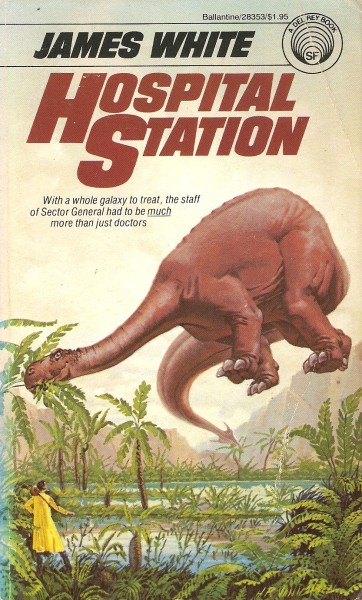

|
| Cover art by H. R. Van Dongen |
| HOSPITAL STATION James White New York: Ballantine Books, September 1979 |
Rating: 5.0 High |
||||
| ISBN-13 978-0-345-28353-6 | |||||
| ISBN 0-345-28353-8 | 191pp. | SC | $1.95 | ||
"You've got to kill it, Conway!"
Picture a young man, trained in the healing arts, dedicated to the Hippocratic ideal of "First, do no harm." Picture him earning a position on the medical staff of Galactic Sector 12 General Hospital. He might feel himself part of an elite, a cut above the common run of humanity, especially those who took part in the brutal arts of war and policing.
Such a man was young Doctor Conway, and such were his feelings. He looked down on members of the Monitor Corps, the organization charged with keeping order in the galaxy — looked down on them to the extent that he refused to associate with any, even with Major O'Mara, Chief Psychologist of the hospital. Conway would pay dearly for that disdain, and that was only the first installment of many payments. For he had to learn to deal with a multitude of life forms: VTXMs and DBLFs and PVSJs, oh my!1
But the dearest payment was exacted by the AACL who came barreling toward the station in a ship just barely under control; it missed the ships already clustered around it transferring casualties, but plunged into the hospital itself. It lodged in the control room for the gravity grids, where the AACL, still alive and active, began wreaking havoc with the control settings.2 Conway alone was in a position to do something about that. He took the gun offered by the badly injured Monitor, intending merely to wound the rampaging creature...
"It was hard, we know that," said Major O'Mara. The rasp was no longer in his voice and the iron-grey eyes were soft with sympathy, and something akin to pride. "A doctor doesn't have to make a decision like that usually until he's older, more balanced, mature, if ever. You are, or were, just an over-idealistic kid—a bit on the smug and self-righteous side, maybe—who didn't even know what a Monitor really was." – Page 78 |
In the four-letter classification system the first letter was a guide to the general metabolism, the second to the number and distribution of limbs and sense organs, and the rest to a combination of pressure and gravity requirements, which also gave an indication of the physical mass and form of protective tegument a being possessed. A, B, and C first letters were water breathers, D through F warm-blooded oxygen breathers, into which classification most of the intelligent races fell. G to K were also oxygen-breathing, but insectile, light-gravity beings. L and M were also light-gravity, but bird-like. The chlorine breathers were contained in the O and P classifications. After that came the weirdies—radiation-eaters, frigid-blooded or crystalline beings, entities capable of changing physical shape at will, and those possessing various forms of extra-sensory powers. Telepathic species such as the Telfi were given the prefix V.
I give White credit for imagining very interesting aliens and plausible situations of jeopardy into which to insert them. But while entertaining, this is not a very deep novel; it borders on the young-adult category.
There are continuity errors. For example, by his classification scheme the troublesome AACL is a water-breather. But why is this pet clad in a protective suit when its owner, the pilot of the spaceship, is in such dire difficulty it is unable to protect itself or even steer the ship? For another, how likely is it that someone with Conway's attitudes would have made it past the screening to become a staff member at Sector General?
Those nitpicking objections aside, however, Hospital Station is a thoroughly enjoyable series of connected episodes depicting Conway's growth into someone truly worthy of his charge at one of the greatest medical facilities ever conceived in fiction. James White went on to write a whole series of novels based on it and Conway. Those are novels I most likely will never read. But I read this one in my youth, and again recently. I enjoyed it both times, and I give it top marks.
There is a good general discussion of the series at Tor Books, which published the last four novels in the series (previous ones came from Ballantine/Del Rey.) Wikipedia has a good section on critical reactions to the novels. Editions shown are mass-market paperbacks unless otherwise noted.

 To contact Chris Winter, send email to this address.
To contact Chris Winter, send email to this address.